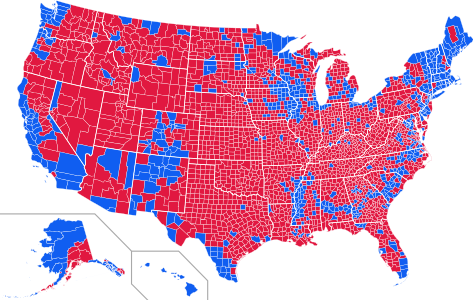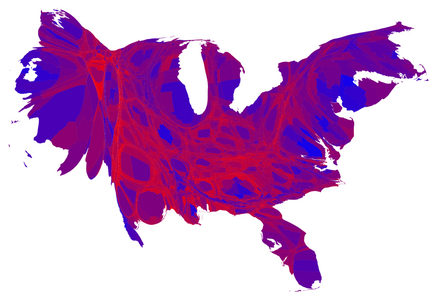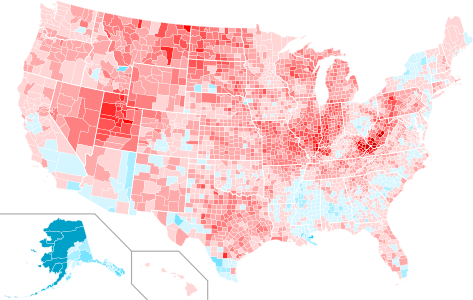2012 United States presidential election
The 2012 United States presidential election was the 57th quadrennial presidential election, held on Tuesday, November 6, 2012. Incumbent Democratic President Barack Obama and his running mate, incumbent Vice President Joe Biden, were re-elected to a second term.[3] They defeated the Republican ticket of former Governor Mitt Romney of Massachusetts and Representative Paul Ryan of Wisconsin.
For related races, see 2012 United States elections.
538 members of the Electoral College
270 electoral votes needed to win
As the incumbent president, Obama secured the Democratic nomination without serious opposition. The Republicans experienced a competitive primary. Romney was consistently competitive in the polls and won the support of many party leaders, but he faced challenges from a number of more conservative contenders. Romney secured his party's nomination in May, defeating former senator Rick Santorum, former Speaker of the House Newt Gingrich, and Texas congressman Ron Paul, among other candidates.
The campaigns focused heavily on domestic issues, and debate centered largely around sound responses to the Great Recession. Other issues included long-term federal budget issues, the future of social insurance programs, and the Affordable Care Act, Obama's marquee legislative program. Foreign policy was also discussed, including the end of the Iraq War in 2011, military spending, the Iranian nuclear program, and appropriate counteractions to terrorism. Romney attacked Obama's domestic policies as ineffective and financially insolvent while Obama's campaign sought to characterize Romney as a plutocratic businessman who was out of touch with the average American.[4][5] The campaign was marked by a sharp rise in fundraising, including from nominally independent Super PACs.
Obama defeated Romney, winning a majority of both the Electoral College and the popular vote. Obama won 332 electoral votes and 51.1% of the popular vote compared to Romney's 206 electoral votes and 47.2%.[2] The results of the electoral vote were certified by Congress on January 4, 2013.[6] Obama was the first president since Ronald Reagan in 1984 to win a majority of the national popular vote more than once, and the first Democrat to do so since Franklin D. Roosevelt in 1944. Obama also became only the sixth Democratic president in history to win a second term (Andrew Jackson, Grover Cleveland, Woodrow Wilson, Franklin D. Roosevelt, and Bill Clinton), and the third sitting president in a row (after Clinton and George W. Bush) to win a second term.
Obama did not hold onto Indiana, North Carolina, or Nebraska's 2nd congressional district, but crucially won all 18 "blue wall" states and defeated Romney in other swing states the Republicans had won in 2000 and 2004, most notably Colorado, Florida, Ohio, and Virginia. Ultimately, of the nine swing states identified by The Washington Post in the 2012 election, Obama won eight, losing only North Carolina.[7] This is the most recent presidential election in which the Democratic candidate won the states of Iowa, Ohio, and Florida, along with Maine's 2nd congressional district, the most recent presidential election in which the incumbent president won reelection, and the most recent in which neither major party's ticket included a woman. This was the last election in which a presidential candidate received above 70% of the vote in any state, with Hawaii for Obama and Utah for Romney. This is also the last election in which Trump was not the Republican nominee.
All four major candidates for president and vice president went on to hold significant public office after this election. Obama served his second term as president, while Biden also served his second term as vice president and initially retired from politics but was later elected president in 2020, defeating Obama's successor, then-incumbent Donald Trump. This is the most recent election in which two major party nominees would go on to become president. Romney moved to Utah in 2014 and was elected to the Senate there in 2018, succeeding Orrin Hatch. Ryan served three more terms in the House and eventually became Speaker from 2015 until his retirement from politics in 2019.
State changes to voter registration and electoral rules[edit]
In 2011, several state legislatures passed new voting laws, especially pertaining to voter identification, with the stated purpose of combating voter fraud; the laws were attacked, however, by the Democratic Party as attempts to suppress voting among its supporters and to improve the Republican Party's presidential prospects. Florida, Georgia, Ohio,[8] Tennessee, and West Virginia's state legislatures approved measures to shorten early voting periods. Florida and Iowa barred all felons from voting. Kansas, South Carolina,[9] Tennessee, Texas,[10] and Wisconsin[11] state legislatures passed laws requiring voters to have government-issued IDs before they could cast their ballots. This meant, typically, that people without driver's licenses or passports had to gain new forms of ID. Former president Bill Clinton denounced them, saying, "There has never been in my lifetime, since we got rid of the poll tax and all the Jim Crow burdens on voting, the determined effort to limit the franchise that we see today".[12] He was referring to Jim Crow laws passed in southern states near the turn of the twentieth century that disenfranchised most blacks from voting and excluded them from the political process for more than six decades. Clinton said the moves would effectively disenfranchise core voter blocs that trend liberal, including college students, black people, and Latinos.[13][14] The Obama campaign fought against the Ohio law, pushing for a petition and statewide referendum to repeal it in time for the 2012 election.[15]
In addition, the Pennsylvania legislature proposed a plan to change its representation in the electoral college from the traditional winner-take-all model to a district-by-district model.[16] As the governorship and both houses of its legislature were Republican-controlled, the move was viewed by some as an attempt to reduce Democratic chances.[17][18][19] Ultimately they did not do it, leaving their winner take all format intact as of 2020.
Results[edit]
Electoral results[edit]
On the day of the election, spread betting firm Spreadex were offering an Obama Electoral College Votes spread of 296–300 to Romney's 239–243.[118] In reality Obama's victory over Romney was far greater, winning 332 electoral votes to Romney's 206. Romney lost all but one of nine battleground states, and received 47 percent of the nationwide popular vote to Obama's 51 percent.[119][120]
Of the 3,154 counties/districts/independent cities making returns, Romney won the most popular votes in 2,447 (77.58%) while Obama carried 707 (22.42%).
Popular vote totals are from the Federal Election Commission report.[2]
Analysis[edit]
Combined with the re-election victories of his two immediate predecessors, Bill Clinton (1996) and George W. Bush (2004), Obama's victory in the 2012 election marked only the second time in American history that three consecutive presidents were each elected to two full terms after the consecutive two-term presidencies of Thomas Jefferson, James Madison, and James Monroe ending in 1820, which is the only other time any two-term president succeeded another.[146] This was also the first election since 1928 in which neither of the major candidates had any military experience.[147] Eight years later, Obama's successor, Donald Trump, also ran for his own re-election in 2020, but ultimately defeated by Joe Biden, who served as vice president under Obama.
The 2012 election marked the first time since Franklin D. Roosevelt's last two re-elections in 1940 and 1944 that the incumbent Democratic president won a majority of the popular vote in two consecutive elections.[148] Obama was also the first president of either party to secure a majority of the popular vote in two elections since Ronald Reagan in 1980 and 1984.[149] Obama is the third Democratic president to secure at least 51% of the vote twice, after Andrew Jackson and Franklin D. Roosevelt.[150] Romney won the popular vote in 226 congressional districts making this the first time since 1960 that the winner of the election did not win the popular vote in a majority of the congressional districts.[151]
Romney lost his home state of Massachusetts, becoming the first major party presidential candidate to lose his home state since Democrat Al Gore lost his home state of Tennessee to Republican George W. Bush in the 2000 election.[152] Romney lost his home state by more than 23%, the worst losing margin for a major party candidate since John Frémont in 1856.[153] Even worse than Frémont, Romney failed to win a single county in his home state, something last seen by Theodore Roosevelt in 1912.[154][155] In addition, since Obama carried Ryan's home state of Wisconsin, the Romney–Ryan ticket was the first major party ticket since the 1972 election to have both of its nominees lose their home states.[156] Romney won the popular vote in every county of three states: Utah, Oklahoma, and West Virginia; Obama did so in four states: Vermont, Massachusetts, Rhode Island, and Hawaii.[157]
Romney's loss prompted the Republican National Committee to try to appeal to the American Latino population by concentrating on different approaches to immigration. These were short-lived due to activity and anger from the Republican base and may have contributed to the selection of Donald Trump as their presidential candidate four years later.[158]
Gary Johnson's popular vote total set a Libertarian Party record, and his popular vote percentage was the second-best showing for a Libertarian in a presidential election, trailing only Ed Clark's in 1980.[159] Johnson would go on to beat this record in the 2016 presidential election, winning the most votes for the Libertarian ticket in history. At the time, Green Party candidate Jill Stein's popular vote total made her the most successful female presidential candidate in a general election in United States history.[160][161] This was later surpassed by Hillary Clinton in the 2016 election.
Obama's vote total was the fourth most votes received in the history of presidential elections (behind Obama's 2008 victory and both major candidates in 2020) and the most ever for a reelected president. The 2012 election marked the first time since 1988 in which no state was won by a candidate with a plurality of the state's popular vote. Furthermore, it is the only post-World War II presidential election in which no states were won by margins smaller than 30,000 votes. Obama's narrowest victories were in New Hampshire by 39,643 votes, followed by Florida by 74,309 votes. Every other presidential election in modern history has seen states narrowly won by several thousand votes. So far, this is the only presidential election in history where both the Republican and Democratic vice presidential candidates are practicing Roman Catholics. It is also the only presidential election where there are no white Protestants on either major party ticket.
Obama was the fourth of just four presidents in United States history to win re-election with a lower percentage of the electoral vote than in their prior elections, the other three were James Madison in 1812, Woodrow Wilson in 1916 and Franklin Roosevelt in 1940 and 1944. Additionally, Obama was the fifth of only five presidents to win re-election with a smaller percentage of the popular vote than in prior elections, the other four are James Madison in 1812, Andrew Jackson in 1832, Grover Cleveland in 1892, and Franklin Roosevelt in 1940 and 1944.










![The Empire State Building in New York City was lit blue when CNN called Ohio for Obama, projecting him the winner of the election. Likewise, red would have been used if Romney won.[162]](http://upload.wikimedia.org/wikipedia/commons/thumb/4/4f/Empire_State_Building_Blue_Obama_Election.JPG/273px-Empire_State_Building_Blue_Obama_Election.JPG)


